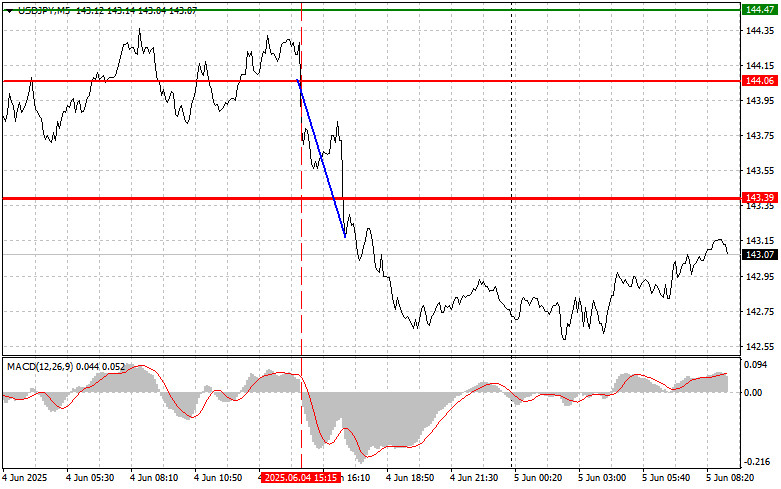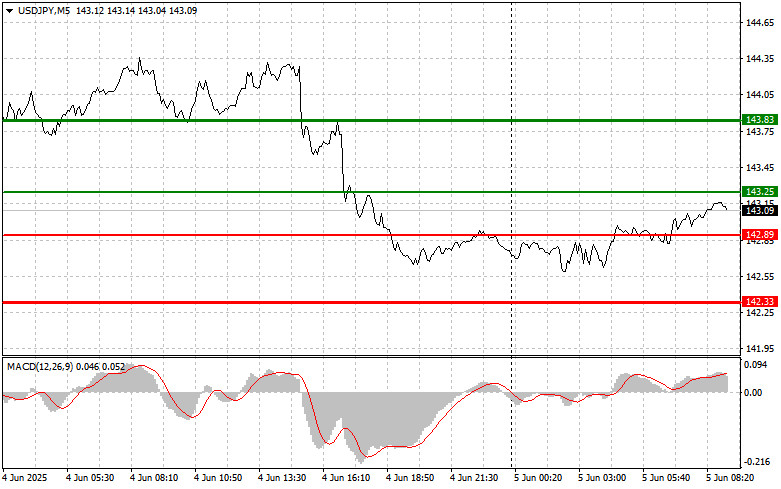Analysis of Trades and Trading Tips for the Japanese Yen
The price test at 144.06 coincided with the moment when the MACD indicator had just started moving downward from the zero line, confirming a correct entry point for selling the dollar. As a result, the pair plunged toward the target level of 143.39.
Yesterday was marked by significant fluctuations in the currency market, triggered by the release of disappointing data from the United States. The ADP employment report showed a much smaller job increase than expected, and weak ISM services sector figures created a domino effect, leading to a rise in the Japanese yen and a corresponding decline in the US dollar. The market's reaction was swift. Concerned about slowing US economic growth, traders began shedding dollar assets and shifting into traditional "safe-haven" currencies like the yen. This process was further intensified by revised expectations regarding the Federal Reserve's future monetary policy.
Today's weak wage growth data had little impact on the currency market. It appears that market participants had already factored such results into their forecasts, expecting a correction after previously more optimistic reports. Overall, investors are currently focused on more significant indicators of economic health, such as inflation and GDP growth rates.
For intraday strategy, I will focus primarily on implementing Scenarios #1 and #2.
Buy Scenario
Scenario #1: Today, I plan to buy USD/JPY at the entry point around 143.25 (green line on the chart), targeting a rise toward 143.83 (thicker green line). Around 143.83, I plan to exit long positions and open shorts in the opposite direction, aiming for a move of 30–35 pips in reverse. It's advisable to wait until the price corrects and experiences significant pullbacks before buying the pair again.
Important! Before buying, ensure that the MACD indicator is above the zero line and beginning to move upward.
Scenario #2: I also plan to buy USD/JPY today in case of two consecutive tests of the 142.89 price level when the MACD indicator is in the oversold zone. This will limit the downside potential and lead to an upward market reversal. Expect a rise toward the opposite levels of 143.25 and 143.83.
Sell Scenario
Scenario #1: I plan to sell USD/JPY only after the 142.89 level (red line on the chart) is breached, which should lead to a quick drop in the pair. The key target for sellers will be the 142.33 level, where I plan to exit short positions and immediately open long positions, aiming for a move of 20–25 pips in the opposite direction. Selling pressure could return quickly today.
Important! Before selling, ensure that the MACD indicator is below the zero line and just beginning its downward movement.
Scenario #2: I also plan to sell USD/JPY today in case of two consecutive tests of the 143.25 price level when the MACD indicator is in the overbought zone. This will limit the pair's upside potential and lead to a downward reversal. Expect a drop toward the opposite levels of 142.89 and 142.33.
What's on the Chart:
- The thin green line represents the entry price where the trading instrument can be bought.
- The thick green line indicates the expected price level where a Take Profit order can be placed, or profits can be manually secured, as further price growth above this level is unlikely.
- The thin red line represents the entry price where the trading instrument can be sold.
- The thick red line indicates the expected price level where a Take Profit order can be placed, or profits can be manually secured, as further price decline below this level is unlikely.
- The MACD indicator should be used to assess overbought and oversold zones when entering the market.
Important Notes:
- Beginner Forex traders should exercise extreme caution when making market entry decisions. It is advisable to stay out of the market before the release of important fundamental reports to avoid exposure to sharp price fluctuations. If you choose to trade during news releases, always use stop-loss orders to minimize potential losses. Trading without stop-loss orders can quickly wipe out your entire deposit, especially if you neglect money management principles and trade with high volumes.
- Remember, successful trading requires a well-defined trading plan, similar to the one outlined above. Making impulsive trading decisions based on the current market situation is a losing strategy for intraday traders.














